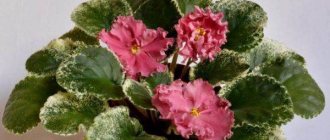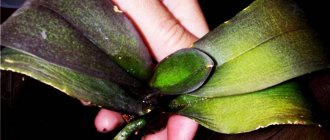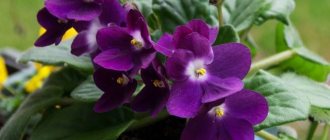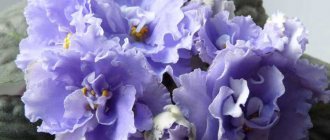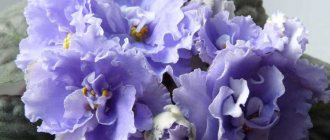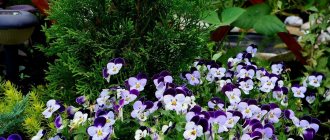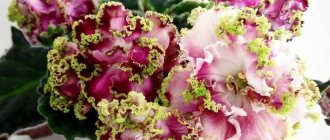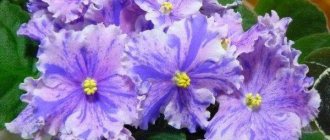Breeders are not always able to register a newly created variety of Uzambara violet as a variety.
may arise in the life processes of such a candidate, which do not satisfy the requirements of the masters for the quality characteristics of the variety.
But the bred plant can
stand out for its unusual decorativeness , particularly long flowering or some other striking feature, which is why the breeder considers it impossible to simply consign the violet to oblivion.
In this case, the variety in the status of “seedling” goes to violet growers. Seedlings have every right to independent existence , as they are characterized by the same simple care regimes, unpretentious characters and attractive silhouettes as varietal specimens.
Flower growers are happy to :
- Seedlings are bred in their collections;
- Names are assigned to them;
- Contribute to their spread.
Due to their popularity among violet growers and the persistence of life processes, some seedlings deserve from their authors the right to be called a variety .
IMPORTANT! To keep even novice flower growers in their collections, we can recommend the seedling “SM-Stassia”, which is distinguished by its chic colors and ease of care.
What does Esmeralda violet look like?
Violet LE Esmeralda is a delicate, touching flower that does not stand out with particular brightness or splendor. But at the same time, the flowering is abundant, due to which this whole amazing picture is created.
Violet LE Esmeralda
Plant characteristics
Botanical description of Saintpaulia Esmeralda:
- the flower is large, bright crimson in color, with fringe along the edges;
- along the edge of each petal there is a light green edging, which brightens over time;
- leaves of a standard oval shape, slightly tapering towards the end, become wavy over time;
- The color of the edging can be maintained if the room temperature is maintained at a consistently cool temperature.
Interesting! The main feature of this plant is that even the first flowering is very abundant.
Violet Esmeralda belongs to the Gesnerieceae family, genus Saintpaulia Hybrida.
Briefly about the history of appearance
The violet got its name in honor of the famous gypsy from V. Hugo’s novel “Notre Dame de Paris.” The color of its petals and the lace around the edges reminded the breeders working with the variety of this beautiful girl. The variety has several varieties.
The difference between the varieties Esmeralda and Esmerald Lux
LE Esmeralda Lux is one of the varieties of the hybrid. It was bred by breeder Elena Lebetskaya, who became the author of most varieties. This hybrid is characterized by greater terry and petal size. The color saturation is also slightly different. In this case, they are either raspberry-burgundy or fuchsia. The light green border along the edge of the flower remains unchanged throughout the entire flowering period.
Violet Esmeralda Lux
Sports of this type
A sport of violets is considered to be any minor but regularly recurring difference in a number of plants belonging to a given species. These differences may be expressed in the shape of flowers or leaves. Sport Esmeralda is a completely similar plant, the leaves of which are as curly as the flowers. But the color of the delicate petals itself is completely pink.
Esmeralda - sport of violets
Summary
Violet Stassia: video
Violet Stassia is a violet bush that is loved by many gardeners; this flower is very unpredictable, and hardly anyone can reveal the secret of its flowering. It is impossible to predict what shade the Stassia will bloom in, it will not be possible to determine in advance how abundant and unexpected this flowering will be, and of course this greatly attracts flower growers to such uncertainty. Flowers can be very different not only in the nature of their color, but also in their shape, since they can be very double, semi-double, they can be very large, and there are also dwarf specimens. Perhaps even the breeder himself did not expect that such a planting would result, and that is why today the Stassia violet is so in demand and interesting within the framework of indoor floriculture.
In general, violets are very attractive plantings, so it is imperative to monitor them and their general condition, because this is the only way to preserve not only the external characteristics of the violet bush, but also the beauty of its flowers. By the way, flowering can be extended precisely due to competent agricultural technology, providing the Stassia Moreva violet with care and all possible conditions so that it is content and feels full. The temperature should not drop too much, air humidity should be within normal limits, and it is also necessary to regularly monitor the Stassia violet variety. To do this, it is examined for diseases or emerging bacteria and pests. It is worthwhile to prevent diseases and pest attacks, and take care to increase the plant’s immunity. This is the only way to achieve reciprocity from the Stassia violet in the form of beautiful flowering.
Features of caring for violet LE Esmeralda at home
Like any Saintpaulia, LE Esmeralda is a rather finicky plant, but any gardener can cope with its cultivation, especially an experienced one, one who has been breeding violets for a long time.
Temperature and lighting
Violet Ice Rose - description and characteristics of the variety
The optimal growing temperature is +18..+24 °C. The cooler the room, the lighter the petals.
Proper lighting is one of the components of success in growing violets. Daylight hours should always last long, not only in summer, but also in winter. Therefore, at this time of year, it is necessary to artificially increase the duration of daylight hours using fluorescent or phyto lamps. In total, violets should be illuminated for at least 15 hours a day.
Important! In summer, pots should not be placed on window sills, especially on the south side. In hot sunny weather, it is better to move them further away, since the delicate leaves of Esmeralda can be seriously damaged by sunburn.
Watering, spraying and humidity
Wick watering or watering through a tray is preferable. The water should be warm, soft, well settled.
Violets should not be sprayed, as droplets of moisture cause yellow spots to form on the leaves. The leaves and flowers of the plant, in principle, prefer only bottom watering (through a tray or wick), but you can carefully water the flowers up to the root.
Violets do not like it when the room is dry. Therefore, the air must be humidified. This can be done using containers filled with water, wet expanded clay, and wet moss. For those who have entire collections of Saintpaulias and other moisture-loving plants, it is recommended to purchase an air humidifier.
Wick watering of violets
Priming
The main properties of soil for violets: nutritional value and friability. It is best to purchase special soil for Saintpaulias in the store. But you need to carefully look at its composition. If there is no perlite in it initially, then it is worth adding it or coarse river sand.
Feeding
During the first 6 months after transplantation, no feeding is required. They are then applied according to life stage.
- At the very beginning of the growing season, nitrogenous fertilizers are applied, which stimulate the active growth of the green part.
- During the flowering period, potassium-phosphorus fertilizers are applied, which promote more luxuriant flowering.
Fertilizing is done in conjunction with watering. If watering is wick, fertilizers are applied directly to the water.
RS-Favorite Blues
Another variety of breeding research by S.N. Repkina , presented to flower growers in 2011 . You can see a photo of the violet RS-Favorite Blues below.
Species affiliation
The violet variety “Favorite Blues” is of the standard type , of the terry type in terms of the number of petals in the bud, and of the finger type in terms of color.
Description
Specimens of the variety are distinguished by a standard-sized rosette, the outline of which is sometimes somewhat ragged. The fullness of the socket is achieved only with age. The leaves have an oval-elongated configuration and are colored in dark shades of green. The reverse side has a reddish tint.
The “Favorite Blues” violet blooms in a bouquet type : large corolla balls are tightly located in the center of the rosette.
Terry is achieved due to the number of petals and the waviness of their tips.
The color of the violet is distinguished by delicate shades - the white petals are filled in a chaotic manner with blurry spots of lilac with transitions of tinting intensity.
Features of growth and flowering
Saintpaulias bloom the first time with the formation of a large number of buds . Further flowering can flow from one to another, the violet does not even take time to rest.
If the care regime is violated, the leaf plates of the violet begin to bend upward, which disrupts the decorative effect of the specimen.
The nuances of keeping indoor culture
An unpretentious variety , it blooms a lot and often under any conditions. The florist only needs to follow all care regimens.
You should not keep fluorescent lamps close to the leaves - from the bright light, the leaf plates bend upward and try to fold in half.
Reviews
Fedor Petrovich. “I advise beginning flower growers to purchase the “Favorite Blues” variety from the collection. Violet does not require care and is always in bloom or in buds. Add cute lilac pom-pom-shaped flowers and you get the idea of Saintpaulia. I won’t be lying if I say that these are now my favorite violets.”
Lyudmila Mikhailovna. “They gave me a small violet. At first I wasn’t impressed by it – just a green bush. But when it bloomed, I fell in love with it. A most delicate, airy bouquet of white and lilac color, very similar to a bride’s bouquet, blossomed in the center.”
When and how does it bloom
Violet Fairy - description and characteristics of the variety
The plant blooms throughout almost the entire year. The flowers are cute and original. They can be plain or terry, depending on the particular variety of Esmeralda, with fringed edges.
The flower shape of this species is Pansy.
The plant blooms almost all year round, with the exception of a short dormant period of 1-2 months.
No special changes in care are required during flowering. It is important to remove dried buds in a timely manner. Fertilizing with complex fertilizers is carried out 2 times a month.
AB-Favorite toy
Below you see a photo of the AB-Lubimaya Igrushka violet, a charming variety bred by breeder Alexey Vsevolodovich Tarasov. Violet appeared at exhibitions in 2015.
Species affiliation
There is no clear opinion regarding the species classification of this variety: some gardeners classify it as a small standard , but many prefer to consider it semi-mini.
Description
In accordance with the characteristics of semi-mini varieties, violet forms a very compact and small leaf rosette. The almost round leaves have a wavy serration along the contour and are colored in shades of fresh grass.
The petioles of the leaf blades are thick and somewhat long, but this does not interfere with the perception of the variety.
The variety forms buds in a cap type . The corollas are not very large, terry in appearance. Each petal has a corrugated structure.
In the center of the bud you can see a pink-crimson spot, from which a pink glow spreads across the white petals.
The edges of the petals are framed with a burgundy welt. There are dark pink splashes on the entire surface of the flower.
Features of growth and development
With abundant flowering, the cap of the corollas can almost completely cover the rosette of leaves.
The crimson border of the flowers acquires tonal saturation from flowering to flowering; the same effect is obtained when keeping specimens in cool conditions.
Important! Violet “Favorite Toy” is capable of producing sports with beet-colored corollas.
The nuances of keeping indoor culture
To make it more decorative in the form of a crimson border, the violet should be kept in cool conditions . The rest is care according to the standard scheme.
It should be especially protected from drafts and not placed on cold window sills.
Reviews
Sonechka. “I’ve wanted a small violet for a long time. Finally, they gave me a “Favorite Toy” for my birthday. The best gift! She is so cute and very small! A real toy!”
Alexei. “I gave my wife a new treat for March 8 – a violet “Favorite Toy.” Now I constantly look at the curls of her fringe. And the wife does not leave the flower, she reads literature on care. Thanks to the author of violet - I am now the best husband in the world. But we need new mini violets.”
How Saintpaulia LE Esmeralda propagates
Propagation of the large-flowered Saintpaulia LE Esmeralda occurs only by cuttings or peduncles. The most popular method is cuttings.
Violet Magenta - description and characteristics of the variety
To do this, select the strongest sheet from the second row. It is placed in a glass with warm boiled water. As soon as the root system grows to about 1 cm, the shoot can be planted in the prepared soil.
It is possible to plant the leaf in the substrate immediately. It needs to be buried approximately 1/3 of the entire length and covered with polyethylene or a glass jar.
Attention! Every day the shelter must be raised for ventilation, and the level of soil moisture must be monitored so that it does not dry out.
Violet cuttings
EL-Pet
Saintpaulia breeding development by L.A. Eremenko.
Species affiliation
The fantasy variety , in terms of the size of the leaf rosette , belongs to the semi-miniature group, and in terms of the color of the leaves, it belongs to the variegated variety.
Description
The violet forms a dense rosette with an even contour.
The slightly pointed leaf plates have an original color: yellowish-green spots are scattered across the overall dark background, and the leaf veins are tinted with emerald green.
The variety blooms according to the cap type. On very strong peduncles there are corollas of a semi-double configuration.
The color of the flowers is fantastic - pinkish-lilac petals are completely splashed with specks of purple tones.
Features of growth and flowering
Violet EL-Lubimchik forms a rich cap the first time . It blooms for a very long time, sometimes forgetting to leave time to rest.
Violet propagates easily and simply.
The nuances of keeping indoor culture
The variety is perfect for growing your first violets. Completely unpretentious, it allows itself to be replanted in a blooming state without dropping the buds - but such experiments can be carried out only in the most extreme cases.
Reviews
Boris. “The variety “Favorite” completely unexpectedly appeared in my collection (I took away a dying violet from a bakery seller) and really became my favorite. After I managed to get it out, the bush pleases with almost constant flowering. And its flowers are magnificent, pink with blue-violet fantasy.”
Kristina Anatolyevna. “The “Favorite” violet was given to me to start my collection. It has taken root perfectly, blooms very long and beautifully. Now I reproduce it and give it to my friends.”
Transplantation after purchase and during reproduction
After purchasing a violet, you should not replant it immediately. It must go through the incubation period in the same container in which it grew in the store. For 14 days, the plant should be protected from the rest; it is advisable to place it in a separate room. This is necessary in order to protect home flowers from diseases and parasites that Saintpaulia can bring with it.
Further transplantation is carried out by transshipment. Transplantation to a new place is carried out once every 2 years, more often, but not less often. The size of the pot should increase slightly each time, but it should not be too deep.
In a large pot, the growth of the plant will slow down, since it will be absorbed primarily by building up the root system. Only after it has entwined the earthen lump will the ground part begin to develop.
Reviews
Veronica. “ I can’t understand why K. Morev didn’t register his “Stassia” as a variety. A gorgeous violet that doesn’t let you get bored at all: every time you don’t know how it will color its corollas. In winter, the seedling is usually light in color; in summer, it is the color of a juicy cherry or with soft pink streaks. It’s incredibly beautiful and exciting.”
Violet attracts the attention of flower growers.
Possible problems in growing
Most problems occur due to improper care, but there are also diseases to which Saintpaulias are predisposed. Occasionally, violets are attacked by insect pests.
Problems with leaves
Problems with leaves are most often associated with improper care. Thus, yellowing and the appearance of spots on the leaves are most often associated with hypothermia. Watering with cold water or excess moisture can provoke the development of root or stem rot, causing the leaves to droop and turn black.
Lack of light will cause the cuttings to stretch and elongate. And excess lighting and heat can cause wilting, drying out and sunburn on the leaf part.
Pests
The main parasitic insects that can harm Saintpaulia LE Esmeralda:
- Ticks that cannot be seen with the naked eye. They settle on aging leaves. Traces of their vital activity appear in the form of white dots on the leaves. Leaves affected by mites are cut off.
- Thrips. They can also only be seen under a microscope, but unlike ticks, they can fly. Houseplants most often get pollen or poplar fluff from the street.
- Aphids can kill violets. The external manifestation of its vital activity is the withering of the leaves, which then turn yellow and fall off.
To combat any insect pests, special preparations are used - insecticides, which can be bought at any flower shop.
Diseases
The most common diseases are:
- Powdery mildew (real or downy) is characterized by the appearance of a powdery white coating on leaves and stems. The false variety is also accompanied by brown spots on the leaf blades.
- Rust affects the leaves, which become covered with rusty spots, then the rest of the flower suffers.
- Root and stem rot are the most dangerous diseases that occur in Saintpaulias as a result of hypothermia and/or overwatering. The appearance of this disease is detrimental to plants. If found, the flower can be thrown away, since it cannot be saved, but the pot can be thoroughly disinfected.
Powdery mildew on violet
Signs of improper care
- with a lack of light, new leaves will be lighter and smaller, the petioles will be stretched, the edges of the leaves will bend upward;
- increased acidity or excessive salinity of the soil leads to curling of leaf plates, the same problem occurs with a lack of nitrogen or overwatering;
- light spots on the leaves or their tips hint to the grower that the flower is watered with too cold water or is suffering from sunburn.
It is better for beginners not to start growing this plant; it is worth practicing on more unpretentious flowers.
Saintpaulia Esmeralda fully lives up to its name with its bright double flowers, of which there are many, starting from the first flowering. This variety will definitely decorate any collection. However, it is better for beginners not to start growing this variety, since it is not so easy to cope with.
EK-Gift for a loved one
The variegated variety represents the breeding developments of the Togliatti florist Elena Vasilyevna Korshunova . The variety was introduced in 2008.
Species affiliation
The photo and description of the violet EK-Gift for a Beloved make it clear that the variety can be classified according to the standard type , since it forms a neat, medium-sized rosette of leaves.
According to the color of the leaf blades, the plant belongs to the variegated type, according to the color scheme - to the edged type, and according to the number of petals - to the terry type.
Description
In adulthood, the flower has a neat leaf rosette with a symmetrical outline. Leathery, rounded-angular leaves are painted in a very dark tone of green with a frame of thick dotted pinkish tint.
Even a non-flowering Saintpaulia will certainly attract attention with the beauty of the bush.
Belongs to the group of varieties with cap flowering . Large corollas on strong peduncles consist of several layers of petals, due to which a double flower is formed.
Greater volume is given by the fine and frequent fringe of the tips of each petal.
The color scheme is in lilac-blue shades of varying color intensities; a purple ribbon with purple reflections is running across the entire width of the fringe.
Features of growth and flowering
The variety is distinguished by strong characteristics of any stage of the life cycle:
- characterized by rapid growth;
- from the first flowering it gives a magnificent volume of the cap;
- elastic peduncles allow heavy corollas to stay straight;
- Saintpaulia blooms for quite a long time;
- does not impose special requirements on lighting conditions;
- forms a strong root system.
IMPORTANT! The variety is ideal for collectors who constantly participate in various exhibitions, as it likes to independently form a rosette of leaves - and it turns out to be perfectly even.
The nuances of keeping indoor culture
Even beginners in the field of growing violets can cope with this variety. He is not capricious at all, although he belongs to the variegated varieties. The main thing for a florist is to carefully follow standard care regimens.
You can pay attention to the amount of nitrogen when feeding, since overfeeding can lead to the disappearance of leaf variegation.
Reviews
Ekaterina Semyonovna. “Gift for a Beloved” is one of Elena Vasilievna’s most successful varieties. The violet is not picky, grows quickly, blooms vigorously and early. I’ve had it in my collection for a very long time, I couldn’t be happier with it.”
Konstantin. “It’s strange that not enough attention is paid to Saintpaulia “Gift for a Loved One.” Not only does the variety itself form a rosette and does not require special conditions, it also looks royal at any time, with or without flowers! Thanks to E. Korshunova for this violet.”

